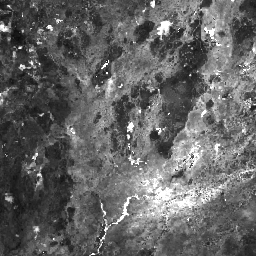Page Summary
-
These are Landsat Collection 2 Tier 1 Level 2 composites created from orthorectified scenes and are available from 1984 to 2025.
-
The dataset provides the Burn Area Index (BAI), which measures the spectral distance of each pixel from a reference spectral point to emphasize the charcoal signal in post-fire images.
-
Composites are generated every 32 days from all scenes within that period, with the most recent pixel value being used.
-
Landsat datasets are in the public domain and require acknowledgement of the U.S. Geological Survey as the data source.

- Dataset Availability
- 1984-01-01T00:00:00Z–2025-12-19T00:00:00Z
- Dataset Provider
- Cadence
- 32 Days
- Tags
Description
These Landsat Collection 2 Tier 1 Level 2 composites are made from Tier 1 Level 2 orthorectified scenes.
The Burn Area Index (BAI) is generated from the Red and Near-IR bands, and measures the spectral distance of each pixel from a reference spectral point (the measured reflectance of charcoal). This index is intended to emphasize the charcoal signal in post-fire images. See Chuvieco et al. (2002) for details.
These composites are created from all the scenes in each 32-day period beginning from the first day of the year and continuing to the 352nd day of the year. The last composite of the year, beginning on day 353, will overlap the first composite of the following year by 20 days. All the images from each 32-day period are included in the composite, with the most recent pixel as the composite value.
Notes:
The code used to create the composites can be seen here.
Only daytime images with WRS_ROW < 122 are included.
For Landsat 7 , images after 2017-01-01 are excluded due to orbital drift.
For Landsat 8, images before 2013-05-01 are excluded due to pointing issues.
Bands
Bands
| Name | Pixel Size | Description |
|---|---|---|
BAI |
30 meters | Burn Area Index |
Terms of Use
Terms of Use
Landsat datasets are federally created data and therefore reside in the public domain and may be used, transferred, or reproduced without copyright restriction.
Acknowledgement or credit of the USGS as data source should be provided by including a line of text citation such as the example shown below.
(Product, Image, Photograph, or Dataset Name) courtesy of the U.S. Geological Survey
Example: Landsat-7 image courtesy of the U.S. Geological Survey
See the USGS Visual Identity System Guidance for further details on proper citation and acknowledgement of USGS products.
Explore with Earth Engine
Code Editor (JavaScript)
var dataset = ee.ImageCollection('LANDSAT/COMPOSITES/C02/T1_L2_32DAY_BAI') .filterDate('2023-01-01', '2023-03-01'); var burnedArea = dataset.select('BAI'); var burnedAreaVis = { min: 0.0, max: 100.0, }; Map.setCenter(21.6, -18, 8); Map.addLayer(burnedArea, burnedAreaVis, 'Burned Area');